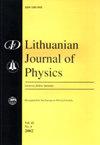立陶宛非医用口罩生产用织物的气溶胶颗粒过滤效率研究
IF 0.3
4区 物理与天体物理
Q4 PHYSICS, MULTIDISCIPLINARY
引用次数: 0
摘要
事实证明,严重急性呼吸综合征冠状病毒2 (SARS-CoV-2)的全球传播对公共卫生构成了挑战。大流行期间,全球对医用口罩的高需求导致决策者在高质量口罩供应方面面临严峻形势。在此期间,世界卫生组织建议在公共场所使用非医用口罩(也称为“社区”口罩),以减少SARS-CoV-2的空气传播。本研究根据CEN车间协议(CWA) 17553:2020的建议,根据过滤效率(FE)和压降(ΔP)两大口罩过滤性能,确定社区口罩中广泛使用的各种面料的过滤效率。为了选择合适的公共口罩材料,必须考虑有限元和ΔP参数的组合。不同织物的过滤效率从6%到100%不等。结果表明,该复合材料具有最高的等效于医用口罩要求的FE (FE > 95%),并得到了16-30 kPa-1的高质量参数的证实。研究发现,在0.54 ~ 1.50 μm粒径范围内,天然纤维(100%棉)织物经镀银处理后的FE(镀银前为18 ~ 40%,镀银后为29 ~ 40%)较高。本文章由计算机程序翻译,如有差异,请以英文原文为准。
Study of the aerosol particle filtration efficiency of fabrics used to manufacture non-medical face masks in Lithuania
The global spread of Severe Acute Respiratory Syndrome Coronavirus 2 (SARS-CoV-2) proved to be a challenge for public health. The high demand of medical masks worldwide during the pandemic has led to a critical situation for decision-makers regarding high-quality mask supply. For this period, the World Health Organization has suggested the use of non-medical face masks (also known as ‘community’ masks) in public places to reduce the airborne spread of SARS-CoV-2. In this study, the filtration efficiency of various fabrics widely used in community masks was determined based on two main mask filtering properties: filtration efficiency (FE) and pressure drop (ΔP) according to the recommendations of the CEN Workshop Agreement (CWA) 17553:2020. The combination of FE and ΔP parameters must be considered in order to select suitable materials for public masks. The filtration efficiencies for various fabrics ranged from 6 to 100%. It was found that the composite materials have the highest FE equivalent to the requirements of a medical mask (FE > 95%), that is confirmed by high-quality parameters 16–30 kPa–1. The study found that fabrics of natural fibres (100% cotton) have a higher FE with Ag coating (18–40% before and 29–40% after coating) in the 0.54–1.50 μm particle size range.
求助全文
通过发布文献求助,成功后即可免费获取论文全文。
去求助
来源期刊

Lithuanian Journal of Physics
物理-物理:综合
CiteScore
0.90
自引率
16.70%
发文量
21
审稿时长
>12 weeks
期刊介绍:
The main aim of the Lithuanian Journal of Physics is to reflect the most recent advances in various fields of theoretical, experimental, and applied physics, including: mathematical and computational physics; subatomic physics; atoms and molecules; chemical physics; electrodynamics and wave processes; nonlinear and coherent optics; spectroscopy.
 求助内容:
求助内容: 应助结果提醒方式:
应助结果提醒方式:


